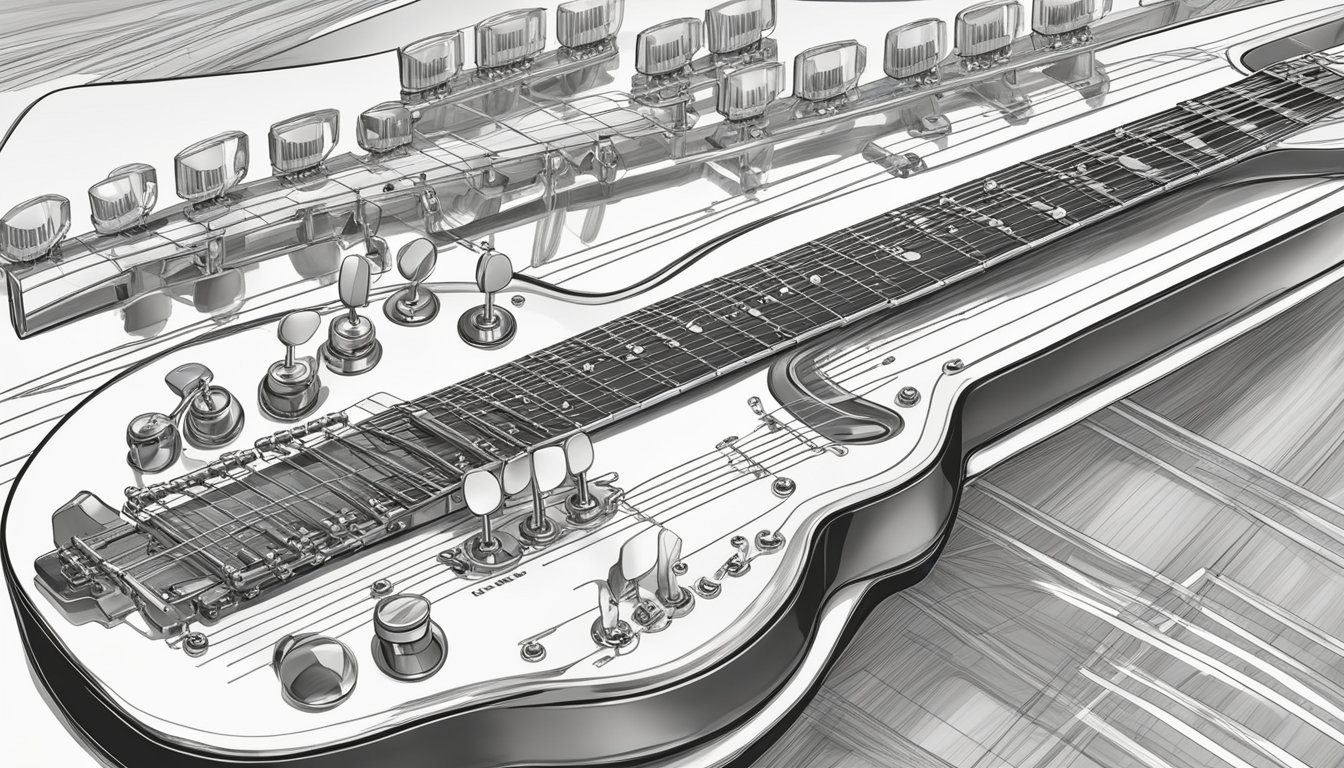When you pick up a guitar, one of the first things you need to know is about its strings.
The six strings on a standard guitar are tuned to specific notes: E, A, D, G, B, and E, from the thickest to the thinnest.
Each string plays a key role in creating different tones and melodies, helping you form chords and play your favorite songs.

Understanding guitar strings goes beyond just knowing their names.
The type of strings you choose can affect your sound and playing style, whether you prefer a bright tone or a warm, rich sound.
Plus, learning how to maintain your strings will keep your guitar sounding great as you develop your skills.
Ready to dive deeper into the world of guitar strings? As you learn about their types, materials, and tuning, you’ll gain valuable insights that will enhance your playing experience and help you advance your skills.
Key Takeaways
- The standard tuning for guitar strings is E, A, D, G, B, and E.
- Different string types can change the tone and feel while playing.
- Proper maintenance keeps your guitar in top shape for practicing and performances.
Basics of Guitar Strings
Guitar strings are essential for making music.
Understanding their names and how they are tuned helps you play your favorite songs.
Let’s dive into the details.
There are six standard strings on a guitar, each producing different notes when played.
To make learning easier, guitar string types explained can help you understand the variations in thickness and materials, which significantly affect the sound quality.
By mastering the characteristics of each string, you’ll be better equipped to choose the right type for your playing style and desired tone.
Understanding Standard Tuning
Standard tuning means tuning your guitar to E-A-D-G-B-E. This means when you play the open strings, you will hear the notes of E, A, D, G, B, and E from the lowest to the highest.
The low E string is the thickest and produces the lowest sound.
Next is the A string, followed by the D string.
The G string comes after, then the B string, and finally, the high E string, which is the thinnest.
This setup allows for a wide range of chords and melodies.
Most songs you’ll learn are based on standard tuning.
String Names and Notes
Each guitar string has a name based on the note it produces when played open.
Here’s a simple list of the strings:
- 1st String: High E (thinnest)
- 2nd String: B
- 3rd String: G
- 4th String: D
- 5th String: A
- 6th String: Low E (thickest)
Remembering the order can be tricky.
You can use a phrase like “Every Adult Dog Growls, Barks, Eats” to help.
Once you grasp this, it gets easier to understand chords and scales.
You’ll find that knowing these strings better will greatly enhance your playing.
Guitar String Types and Materials
When choosing guitar strings, it’s important to understand the differences between string types and the materials they are made from.
Acoustic and electric guitars use different strings, and each type can significantly impact your playing experience and sound.
Acoustic vs Electric Strings
Acoustic guitar strings are typically made of bronze, brass, or phosphor bronze.
These materials provide a warm, resonant sound that is perfect for strumming or fingerpicking.
In contrast, electric guitar strings usually have a core made of high-carbon steel and are often coated with nickel or pure nickel to enhance durability and tone.
Acoustic guitar strings can feel thicker and may have a richer sound, making them ideal for unplugged performances.
Electric guitar strings have a lighter gauge, making them easier to bend and play fast riffs.
If you switch from one type to another, make sure to check your guitar’s compatibility to avoid issues.
Materials and Tones
The materials used for guitar strings directly affect their tone and feel. Steel strings are bright and loud, while nylon strings are softer and smoother, suitable for classical guitars.
Common choices for electric guitar strings include nickel, pure nickel, and pure steel.
Nickel strings offer a warm sound with some brightness, while pure nickel strings provide a vintage feel and warmer tones.
For acoustic guitars, brass strings are often used for their bright sound.
Conversely, phosphor bronze strings deliver a well-balanced tone with clarity.
Choosing the right material will help you achieve the sound you want.
Whether you prefer a warm acoustic tone or a bright electric sound, understanding string types and materials can enhance your playing experience.
Tuning and Maintenance
Keeping your guitar in tune and well-maintained is essential for great sound and playability.
Regular tuning and proper care of your strings can make a big difference in your playing experience.
Tuning Your Guitar
To get started, it’s best to use a guitar tuner.
You can choose from clip-on tuners, pedal tuners, or even apps on your phone.
They help ensure that each string is in the correct pitch.
When tuning, follow this standard order: E (6th string), A (5th string), D (4th string), G (3rd string), B (2nd string), and E (1st string).
If you want to explore other sounds, try alternate tunings like drop D tuning (D A D G B E) or DADGAD tuning (D A D G A D).
After tuning, you should regularly check your tuning because changes in temperature or humidity can affect it.
Using heavier gauge strings may require more frequent tuning, but they’ll produce a deeper tone.
Caring for Your Strings
Taking care of your strings will help them last longer and sound better.
One simple method is to wipe them down after each use.
A soft cloth will help remove sweat and grime.
If you’re using heavy gauge strings, they may take some time to stretch and stay in tune.
Make sure to stretch them gently after installing new ones.
You should also consider changing your strings regularly, especially if you play often.
Old strings can sound dull and can affect your performance.
Aim to replace them every few weeks or sooner if you notice any loss of tone.
Advancing Your Play

Improving your guitar skills involves learning techniques that make it easier to remember string names and experimenting with different ways to tune your guitar.
Let’s break down some helpful tools for learning and explore how alternate tunings can enhance your playing.
Mnemonic Devices for Learning
To remember the names of the strings on your guitar, you can use mnemonic devices.
The standard tuning is E A D G B e, from the lowest (thickest) string to the highest (thinnest) string.
Here’s a simple phrase: “Every Adult Dog Growls Before eating.” Each word corresponds to a string:
- E – lowest string
- A
- D
- G
- B
- e – highest string
Using this phrase can help you recall string names quickly.
Write it on a sticky note and place it on your guitar case or above your practice area.
Practicing with open strings can reinforce this knowledge while you play.
You’ll find that knowing the string notes can make navigating the guitar fretboard a lot easier.
Exploring Alternate Tunings
Exploring alternate guitar tunings can elevate your sound and creativity.
For instance, besides standard EADGBE tuning, there are many popular alternate tunings like Drop D (D A D G B e) and Open G (D G D G B D).
Drop D is great for playing heavier music and allows for deeper bass notes.
Open tunings like Open G can give you a rich, resonant sound perfect for slide guitar.
Experimenting with these tunings can change how you play chords and melodies.
It also allows you to discover new sounds and techniques, making you a better guitarist.
Try playing familiar songs in different tunings to hear how the guitar sound changes!
Frequently Asked Questions
You might have some questions about the strings on your guitar.
Let’s clarify what each string is called, how to remember their order, and how they fit into the world of guitar playing.
What do you call each of the six strings on a guitar?
Each of the six strings on a guitar has a specific name.
From the thickest to the thinnest, they are E, A, D, G, B, and e. Remember that the lower case “e” is the highest pitch string!
Can you name all the guitar strings in order from lowest to highest pitch?
Sure! The strings from the lowest pitch to the highest are E (6th string), A (5th string), D (4th string), G (3rd string), B (2nd string), and e (1st string).
This order is essential for tuning and playing your favorite songs.
What’s a simple trick to remember the order of strings on a guitar?
A simple mnemonic to remember the order is “Eddie Ate Dynamite, Good Bye Eddie.” Each word’s first letter corresponds to the string names E, A, D, G, B, and e. It’s a fun way to keep track of them!
Do guitar strings have specific names or just numbers?
Guitar strings have both names and numbers.
The names correspond to musical notes, while the numbers usually refer to their position on the guitar.
The thickest string is often called the 6th string.
What’s the correct numbering system for guitar strings?
The numbering system starts from the bottom to the top when holding the guitar.
The thinnest string is the 1st string, and the thickest is the 6th.
This system helps with tuning and playing techniques.
How do the strings on a guitar correlate with tablature?
In tablature, each string is represented by a line.
The numbers on the lines indicate which fret to press down.
A “0” means to play the open string, while a “3” means to press the string at the third fret.
This makes it easier to follow along as you play.

